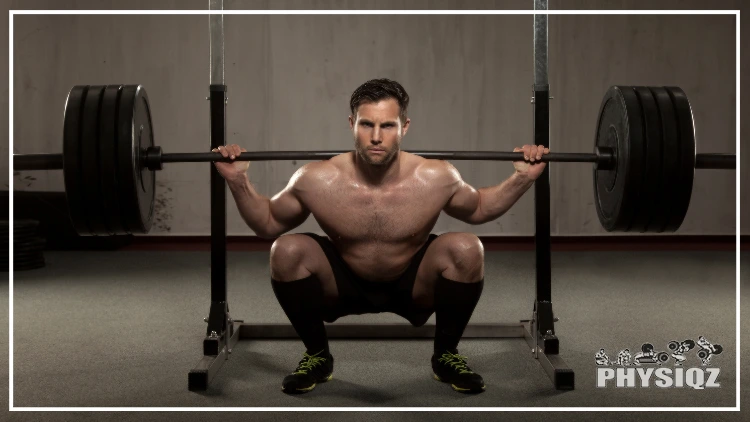
A 405 squat can be considered either impressive or average, depending on the gym you attend, the people you lift with, and your social circle. For some, a 405 squat is an extraordinary achievement, while for others, it may seem like a modest accomplishment.1
Therefore, we’ll break down how much you should squat in comparison to the general population of men by looking at squat strength benchmarks. We’ll also cover how much someone should squat by their skill level, what average people can squat, and how long it’ll take to reach a 4 plate squat.
Is a 405-Pound Squat Impressive? Is 405 Pounds Enough?
Squatting 405 is an amazing achievement that doesn’t belong in the same sentence as the phrase “good enough.” Not only does it take years to get to this level of strength and coordination, but many people will simply never be able to squat that much.
A man squatting 1.5-2.5 times his body weight or a woman squatting 1.5 times her body weight are already coming close to the limit of what most people can achieve, so even phenomenally strong people just won’t reach a 405 squat.
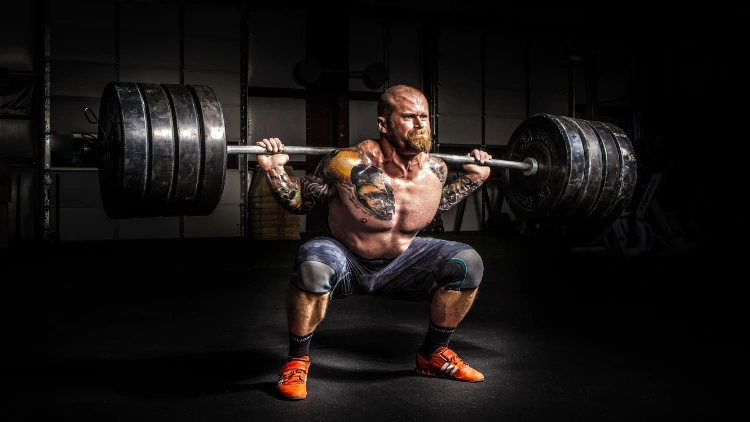
Source: Binyamin Mellish via Canva.com2
For the average person, a 275 squat is already a fairly realistic but respectable goal. Anyone who can achieve a 405 lb squat can be more than satisfied with themselves, knowing that they’ve far surpassed the average male squat max.
How Much Should I Be Squatting for My Skill Level?
Knowing how much a person should be able to squat depends on their experience as well as their weight – but we’ll focus primarily on the experience of the lifter here. A totally untrained squat won’t be very high, even in a large and relatively strong person.
Much like how many people can bench 135 with no training, an untrained squat will typically be around 100 lbs for a man or 60 lbs for a woman. As people move up through the five lifting tiers, though, their squat can double many times from that humble starting weight.
New Lifter: Someone who’s only just begun lifting in the past few weeks is a new lifter. While initial performance will be low even for a strong, healthy person, their squat will grow rapidly as they become accustomed to the motion. Focusing on low, easily controllable weight to build proper form is the most important thing at this stage.
A new lifter will usually be able to squat anywhere from 0-135 pounds since many people start with body weight squats, but people of a heavier body weight might be able to squat upwards of 100 lbs without much training.
Beginner: When a person has been working out for 1-6 months, they occupy the beginner level. By this point, form and the basics should be good, and considerable gains come quickly as long as the person keeps on working at it. Again, depending on someone’s weight and experience, a beginner can usually squat 135+ pounds after a few months worth of training.
Intermediate: Intermediate represents the stage where someone has been training for six months to two years, and it’s the typical point for plateauing. Discipline and a good routine will take someone to the upper intermediate level, but they won’t be able to get any stronger without incorporating advanced training techniques. After completing a beginner hypertrophy program, larger people will be able to squat around 225-275 pounds.
Advanced: After two to five years of working hard and consistently while incorporating advanced lifting techniques into their program, a person will reach the advanced tier. At this point, they’re truly elite lifters that could graduate into the expert class someday. The question of whether a 405 squat is impressive is partly answered by the fact that most people become advanced lifters before they can achieve that weight.
Advanced lifters can usually squat 315+ pounds.
Expert: Less than 1% of the gym-going public qualify as expert lifters. Not only have they been at it for more than five years, but they use all of the most advanced training techniques and follow extremely demanding workout programs.
It’s typical for expert lifters to attend weightlifting competitions and build months-long exercise plans just to maximize their performance at these events.
Expert lifters are generally able to squat 405+ pounds and if you’ve been to a commercial gym lately, this is a pretty rare sight.
Ideal Squatting Weight for Beginners: How Much Should You Start With?
The ideal squatting weight for a beginner varies depending on their size, but choosing a weight that’s too low is always better than choosing one that’s too high. Men who weigh very little might comfortably start with 80 lbs of weight at first to practice form and quickly increase their weight to 100 lbs.
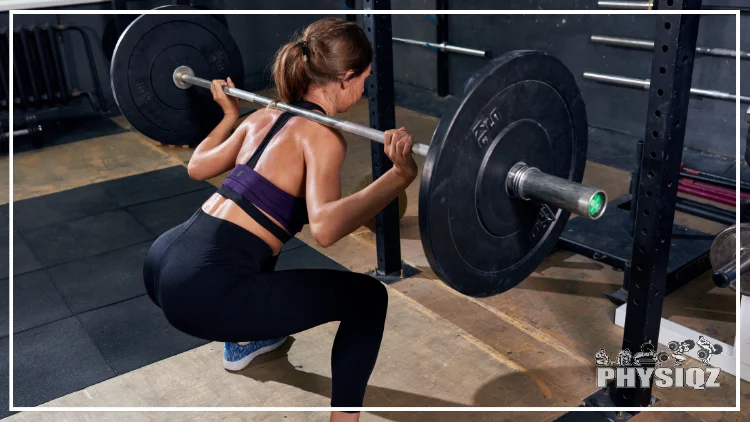
Source: SeventyFour via Canva.com3
On the other hand, a very large man might be comfortable starting out with 135 lbs from their first squat.
Either way, the key to discovering the ideal starting weight as a beginner is to start with a low weight. Find someone who knows how to spot someone squatting so they can check form and ensure safety.
Then, work on discovering a comfortable, controllable weight to start with. When a person can squat that weight for three sets of 12 reps with good form, it’s time to increase the weight.
Squatting Strength Benchmarks for Men
There’s no single number that describes how much men should be able to squat since it’s largely based on weight and experience. Depending on size, the amount of weight a healthy man should be able to squat can range from 175-330 lbs.
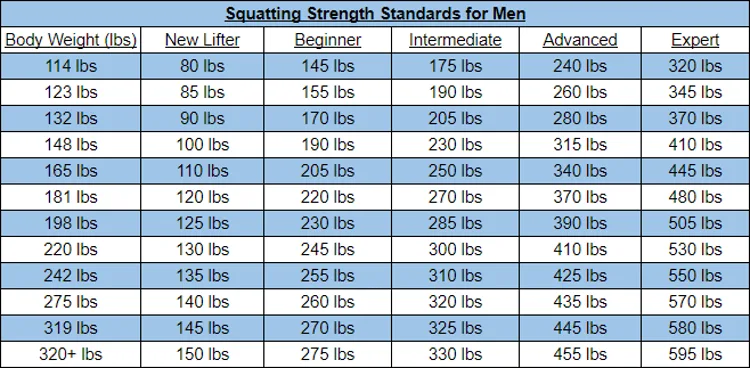
An interesting point to note is that even a 300-pound man won’t achieve a 405 squat as an intermediate lifter. Furthermore, a man below 200 lbs might not even reach it as an advanced lifter.
Squatting Strength Benchmarks for Women
Women’s squatting standards are lower than men’s overall, but there’s also a good rule of thumb to guide how much a woman should squat. If she can squat her body weight, then she has a healthy level of strength.
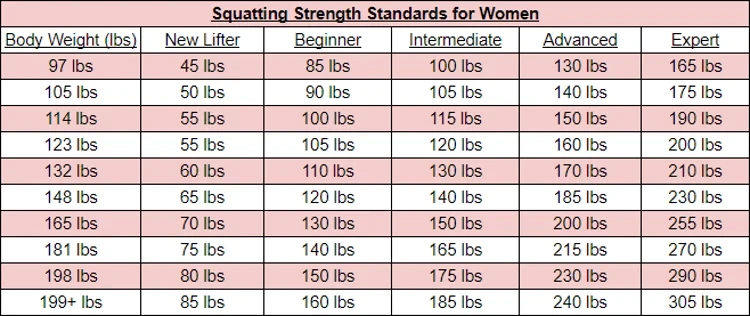
What’s the Ideal Squat Weight for My Body? Evaluating a 405-Pound Squat at Over 200 Pounds
A person who weighs less than 200 lbs can be ecstatic if they can squat about 1.5 times their body weight. While they have a lot of room to go further, it would take great dedication and advanced training techniques to do so.
For men who weigh much more than 200 lbs, though, 1.5 times body weight starts to become a much more elusive goal. Even if a man weighs between 200 and 300 lbs and follows optimal training methods, squatting 405 lbs could realistically take from two to three and a half years.
A 405-pound squat for women is not just good, but an achievement that only world-class female lifters have ever surpassed. In terms of difficulty, squatting 200 pounds as a woman is roughly equivalent to squatting 405 pounds as a man.
A large, 200 lb woman could reach 200 lbs comfortably and would be able to reach 250 or even 300+ lbs with a few years of consistent work.
Male Squat Benchmarks: What is the Average Squat Weight for Men?
It’s difficult to assess the average squatting weight for men and women since many people don’t get enough exercise. If they did, then deciphering the average squat would be as simple as figuring out the standard intermediate squat for the most common body weight. In practice, the numbers will be considerably lower.
Typical Squat Weight for Male
A man of 180 lbs who’s gone to the gym regularly for months and trained the squat can expect to squat more than 250 lbs. However, it has to be said that many men neglect the lower body and favor upper-body workouts.
Considering that many men don’t go to the gym at all, it’s likely that the average squat weight for men around the world is lower than 200 lbs.
Typical Squat Weight for Female
An untrained woman should be able to squat about half of her body weight, and after moderate training, she’ll be able to squat her full body weight. That would put the average squatting weight for women who lift around 150 lbs, but the number must be lower than that.
Considering that only 22.5% of the global population gets enough exercise and has access to good nutrition, the average figure should be closer to 100 lbs.
How Many People Can Lift 225 Pounds in a Squat?
Determining the number of people who can squat 225 pounds in the US and globally is tricky. However, there’s a tested method that’s already been used for estimating how much an average man can bench and how much the average man can deadlift.
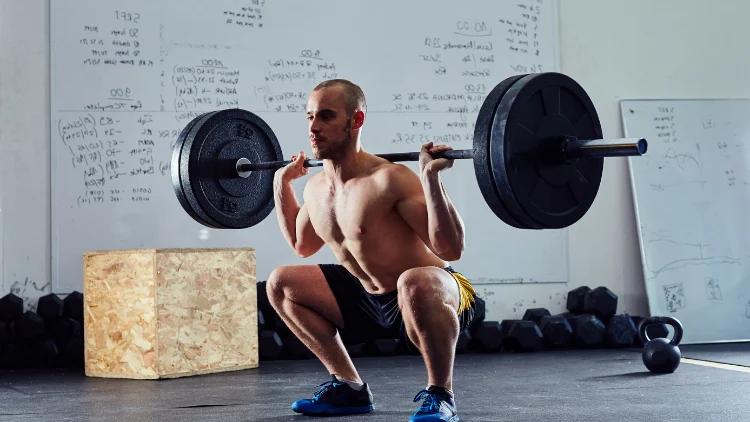
Source: BartekSzewczyk via Canva.com4
By starting with the global population and deducting those who have inadequate nutrition, money, or no access to a gym, researchers answered the question of the number of people capable of benching 225.
The answer was about .075% of the world and 2-3% of the United States. However, that doesn’t answer questions like “how much can the average man carry in a squat.”
Most of the same data from the article on benching 225 apply to squatting, which is to say that only about 22.5% of the population gets adequate nutrition and has access to gym equipment. However, the difference is that squatting 225 is an easier achievement than benching 225.
Comparing the weight and experience tables for benching in the previous article to the tables above for squatting weight reveals that a 225 squat is roughly equal to a 180 bench. With this in mind, it’s likely that about 3-4% of the US population and 0.1% of the world population at large can squat 225.
How To Increase Your Squat Weight to Achieve a 405 lb Squat (Proper Technique for Squatting Heavy)
The first step for anyone to take when they want to become stronger is to revisit the basics. On the one hand, consider the basics of form and how to squat.5 Basic guidelines and an educational depiction of proper technique are available on this Youtube video:
Next, take into account the three pillars of recovery; active rest, adequate nutrition, and sufficient sleep. Don’t push muscles hard for 48-72 hours, but still provide them with mild stimulation during that time frame. Additionally, eat enough protein and work on getting at least seven hours of sleep a night.
From there, consider the following, more advanced techniques. Depending on a person’s size, they should be able to squat 405 within three years by following this advice.
Create A Periodized Training Program
Many people reach an intermediate level of strength doing essentially the same workout program for months or even years. While they might increase weights as they get stronger, they keep their rep and set counts the same.
However, there’s a hard limit to how strong someone can get training like this. This is why a periodized training program that changes up sets, weight, reps, and even exercises is a good way to break plateaus and increase strength.
A basic periodized training program might look like:
- Three weeks of extreme volume with moderate intensity (5 sets of 12-20 reps at 70% 1RM, twice a week)
- Two weeks of moderate intensity and moderate volume (3 sets of 8-12 reps at 80% 1RM)
- Two weeks of high intensity and low volume (3 sets of 3-5 reps at 90% of 1RM)
However, this sort of program can get boring and also creates the risk of losing gains from one phase during another phase. Daily undulating periodization programs are more complicated, as they involve changing up the weight and rep count of sets even on the same day.
It’s more work from the planning side but provides a more interesting workout with potentially better overall gains. In either case, developing a rotating, eight-week powerlifting program will help enhance gains.
Get The Range of Sets & Reps Right
The best rep ranges for mass, hypertrophy, and strength are different, but they’re all important to target. However, the greatest strength gains come from weight, not volume.6 Doing enough work at 80-90% of a person’s 1RM, even if the sets are as short as three reps, goes a long way to promoting strength gain.
Performing squats with maximal weight while incorporating lower weight and higher rep counts with isolating exercises such as the leg press can be one way to reach goals on intensity and volume.
Improve Your Form
Performing proper squats requires balance, flexibility, and full-body coordination as well as strength. If any of these areas are lacking, it will prevent someone from reaching their potential as a lifter.7
Scaling back the weight or incorporating exercises to specifically target these skills creates a better foundation for squatting.
For instance, studies show that a slow-speed, low-weight squat program is especially good at strengthening important supporting muscles such as the knee flexors.8
This sort of accessory work can fit alongside proper back squats on leg day and promote greater gains overall. Also, consider varying between the high bar squat vs low bar squat.
Improving form can also help in these areas, even if it means reducing weight. Many people squat too dynamically, and this reduces the effect of the exercise. Greater depth means greater results when it comes to squatting.9 It’ll also be easier to optimize performance once a person understands the impact of their genetics on their squat form.
Utilize the Bulgarian Squat Method To Increase Weight by 25-50 lbs In A Month
When someone is already a strong lifter and they want to crash through a plateau, they can resort to the Bulgarian squat method. This program eschews the normal guidelines on strength training and emphasizes weight increase through skill training.
While it might not seem like it, squatting is a complex motion that’s about strength as much as it’s about skill.
With the Bulgarian training method, a person will perform heavy squats almost every day for a month, with as little as one rest day per week. There are risks in trying this method without proper research and preparation first. Done right, though, it’s a safe way to make rapid and permanent squatting gains.
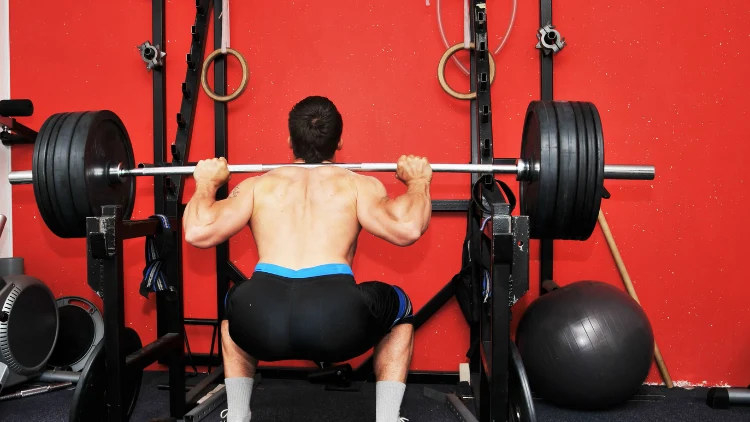
Source: HABY via Canva.com10
How Long to Reach a 405 Pound Squat?
The amount of time that it takes to reach a 405 pound squat is going to vary from person to person, based on all sorts of factors. Assuming that they work hard and smart while getting the proper rest, the only factor remaining is their size.
A diligent, dedicated man of 165 lbs might expect to take four years to reach 405 squat, while a man of 260 lbs could expect to reach the same goal in a little more than two years. As a rough average, hitting 405 in three and a half years is usually going to be a realistic expectation.
Casual lifters often find themselves wondering how much they should be able to squat, especially when they see someone squatting 405 in the gym. However, the answer is a definite yes, as achieving a 405-pound squat is an outstanding accomplishment.
References
1MeikePetri. Canva. Accessed 18 April 2023. <https://www.canva.com/photos/MADaqg6NPh4-athlete-performing-squat-with-barbell/>
2Mellish, Binyamin. Canva. Accessed 18 April 2023. <https://www.canva.com/photos/MADGxidiEGk-man-lifting-barbel/>
3SeventyFour. Canva. Accessed 18 April 2023. <https://www.canva.com/photos/MADF96huw3g-back-view-of-woman-in-shoulder-squat/>
4BartekSzewczyk. Canva. Accessed 18 April 2023. <https://www.canva.com/photos/MADaFUb5ovg-barbell-front-squat-exercise/>
5Lorenzetti, S. (2018, July). How to squat? Effects of various stance widths, foot placement angles and level of experience on knee, hip and trunk motion and loading. NCBI. Accessed December 1st, 2022 from <https://www.ncbi.nlm.nih.gov/pmc/articles/PMC6050697/>
6Schoenfeld, B. J. (2021, February). Loading Recommendations for Muscle Strength, Hypertrophy, and Local Endurance: A Re-Examination of the Repetition Continuum. NCBI. Accessed December 1st, 2022 from <https://www.ncbi.nlm.nih.gov/pmc/articles/PMC7927075/>
7Myer, G. D. (2015, December). The back squat: A proposed assessment of functional deficits and technical factors that limit performance. NCBI. Accessed December 1st, 2022 from <https://www.ncbi.nlm.nih.gov/pmc/articles/PMC4262933/>
8Akagi, R. (2020, July). Eight-Week Low-Intensity Squat Training at Slow Speed Simultaneously Improves Knee and Hip Flexion and Extension Strength. NCBI. Accessed December 1st, 2022 from <https://www.ncbi.nlm.nih.gov/pmc/articles/PMC7396687/>
9Kubo, K. (2019, June). Effects of squat training with different depths on lower limb muscle volumes. NCBI. Accessed December 1st, 2022 from <https://pubmed.ncbi.nlm.nih.gov/31230110/>
10HABY. Canva. Accessed 18 April 2023. <https://www.canva.com/photos/MAEEgClUHfU-barbell-squat/>